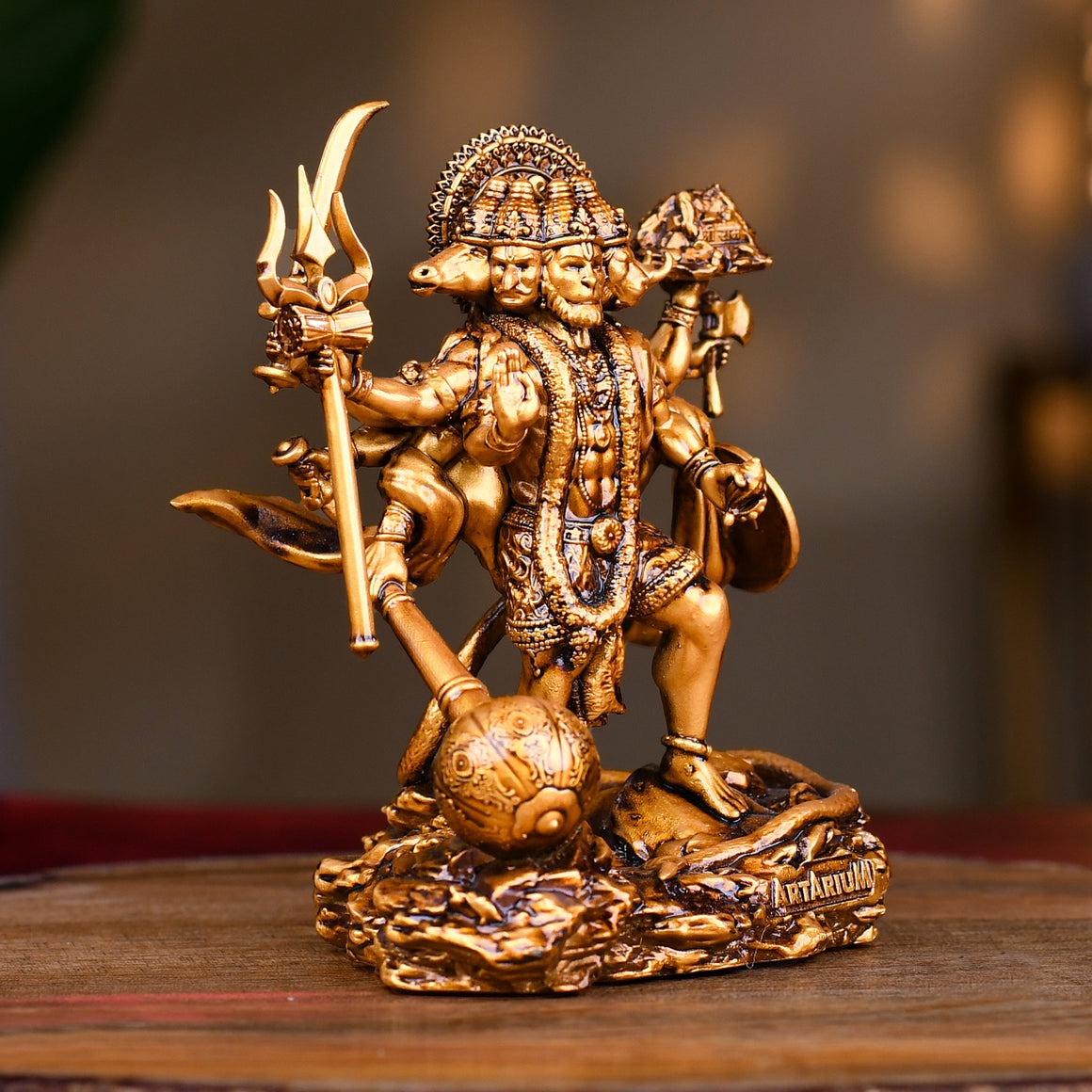Introduction
In the vast landscape of Hindu devotional practices, the Panchmukhi Hanuman Chalisa stands out as a potent spiritual tool. This devotional hymn is dedicated to Panchmukhi Hanuman Ji, a unique and powerful form of Lord Hanuman. With five faces symbolizing various divine attributes, Panchmukhi Hanuman Ji is revered for his protective and transformative powers. The Panchmukhi Hanuman Chalisa, a revered scriptural text, captures the essence of this divine form and offers devotees a profound means of worship and spiritual upliftment.
Understanding Panchmukhi Hanuman Ji
Panchmukhi Hanuman Ji is a distinctive manifestation of Lord Hanuman, the deity known for his immense strength, devotion, and courage. The term “Panchmukhi” translates to “five-faced,” representing a complex and multifaceted divine presence. Each face of Panchmukhi Hanuman Ji is symbolic:
-
Hanuman (East Face): This face represents the core attributes of Hanuman—devotion, strength, and purity. It reflects his role as a devoted servant of Lord Rama.
-
Narasimha (South Face): The lion-faced form signifies protection and the destruction of evil. Narasimha’s fierce appearance is associated with safeguarding devotees from negative influences.
-
Garuda (West Face): The eagle-faced deity embodies speed, vision, and overcoming obstacles. Garuda represents progress and sharp insight.
-
Varaha (North Face): The boar-faced form signifies stability and the restoration of cosmic order. Varaha is linked to maintaining balance in the universe.
-
Hayagriva (Upper Face): The horse-faced deity symbolizes wisdom, knowledge, and intellectual growth. Hayagriva is associated with learning and enlightenment.
Each face of Panchmukhi Hanuman Ji serves a specific purpose, collectively offering a comprehensive form of divine protection and guidance.
The Significance of Panchmukhi Hanuman Chalisa
The Panchmukhi Hanuman Chalisa is a devotional hymn dedicated to this powerful form of Hanuman. Composed in a poetic format, it contains 40 verses (Chalisa) that extol the virtues, power, and divine qualities of Panchmukhi Hanuman Ji. Here’s a closer look at its significance:
1. Spiritual Benefits
The Panchmukhi Hanuman Chalisa is recited for spiritual benefits and blessings. It is believed that chanting or reciting the Chalisa invokes the protective and transformative energies of Panchmukhi Hanuman Ji. Devotees seek his intervention for protection from harm, removal of obstacles, and overall well-being.
2. Devotional Practice
Reciting the Panchmukhi Hanuman Chalisa is a form of devotional practice that strengthens the connection between the devotee and the deity. It is often performed during personal prayers, religious ceremonies, or special occasions. The act of chanting the Chalisa with devotion and sincerity is said to bring divine blessings and grace.
3. Spiritual Protection
The Panchmukhi Hanuman Chalisa is considered a powerful tool for spiritual protection. It is believed to shield the devotee from negative energies, evil influences, and misfortunes. The hymn’s recitation is often associated with seeking safety and security in challenging times.
4. Inner Transformation
Beyond external protection, the Panchmukhi Hanuman Chalisa is thought to facilitate inner transformation. The verses of the Chalisa emphasize qualities such as courage, wisdom, and devotion. Regular recitation helps in cultivating these attributes within oneself, leading to personal growth and spiritual advancement.
The Structure of Panchmukhi Hanuman Chalisa
The Panchmukhi Hanuman Chalisa is composed of 40 verses, each celebrating different aspects of Panchmukhi Hanuman Ji. The verses are written in a rhythmic and poetic format, making them suitable for chanting and memorization. The Chalisa typically includes the following sections:
1. Introduction
The introductory verses of the Chalisa acknowledge the divine presence of Panchmukhi Hanuman Ji and seek his blessings. These verses set the tone for the devotional practice and express reverence towards the deity.
2. Praise and Description
The central verses of the Chalisa describe the various attributes and divine qualities of Panchmukhi Hanuman Ji. They highlight his roles, powers, and the impact of his divine presence. These verses serve as a reminder of Hanuman Ji’s significance and the benefits of his worship.
3. Prayer for Protection
A significant portion of the Chalisa is dedicated to prayers for protection and removal of obstacles. Devotees recite these verses to seek Hanuman Ji’s intervention in safeguarding them from difficulties and challenges.
4. Conclusion
The concluding verses of the Chalisa express gratitude and devotion. They often include a plea for continued blessings and divine grace. The conclusion reinforces the devotee’s commitment to the deity and concludes the devotional practice on a positive note.
How to Recite Panchmukhi Hanuman Chalisa
Reciting the Panchmukhi Hanuman Chalisa requires a sincere and focused approach. Here are some steps to guide the practice:
1. Prepare the Space
Choose a clean and quiet space for recitation. Ensure that the environment is conducive to spiritual practice and free from distractions.
2. Offer Prayers
Begin by offering a short prayer or invocation to seek blessings for the recitation. This may include expressing gratitude and asking for guidance during the practice.
3. Recite the Chalisa
Start reciting the Panchmukhi Hanuman Chalisa with devotion. Chant each verse clearly and with sincerity. You may use a printed text or a recorded version to assist in recitation.
4. Focus and Contemplation
While reciting, focus on the meaning and significance of each verse. Contemplate the divine attributes and qualities of Panchmukhi Hanuman Ji. Allow the devotional practice to inspire and uplift your spirit.
5. Conclude with Gratitude
End the recitation with a closing prayer of gratitude. Express appreciation for the divine presence and seek continued blessings and guidance.
Conclusion
The Panchmukhi Hanuman Chalisa is a powerful and sacred hymn dedicated to the revered form of Panchmukhi Hanuman Ji. Through its verses, devotees seek spiritual benefits, protection, and inner transformation. The Chalisa’s rhythmic and poetic structure enhances its devotional impact, making it a cherished practice for those who revere Hanuman Ji. By incorporating the recitation of Panchmukhi Hanuman Chalisa into daily or special devotional practices, followers can connect deeply with the divine presence and experience the transformative power of this sacred hymn.




